Disclosure: We may earn commissions if you purchase products after clicking on a link from our site.
Do you want to learn how to catch a lot of bluegills? Bluegills are widely available and tasty. This makes bluegill a popular fish among fly-fish anglers. If you want bluegill fishing tips to improve your fishing skills, then after reading this article, you will have learned what to do to catch and take more bluegill home.
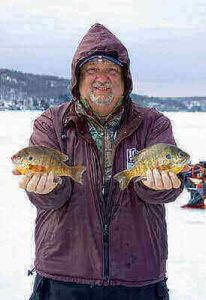
Table of Contents
How To Catch Bluegill
1. Drift Fishing
Drift fishing is used to catch bluegill. When drift fishing, you move the boat over different habitats as the bait moves over the area. This fishing method covers a lot of water and is a very effective fishing method. It usually results in you catching a number of different fish.
Drift fishing is a popular and effective method used by anglers to catch bluegill, prized freshwater panfish known for their abundance and willingness to bite. This technique involves allowing bait or lures to drift naturally with the current while covering a large area of water.
Anglers typically use small hooks baited with live bait such as worms, crickets, or small minnows, or opt for artificial lures like small jigs or spinners. By drifting their bait or lures along the edges of weed beds, around submerged structures, or over shallow flats where bluegill are known to congregate, anglers can entice strikes from these fish.
Drift fishing allows anglers to explore different depths and areas of the water body, increasing their chances of locating active bluegill schools. With its simplicity and effectiveness in targeting bluegill in various environments, drift fishing remains a favored method among anglers seeking a relaxing and productive day on the water.
2. Fly Fishing
Fly fishing is a rewarding and enjoyable method for anglers to target bluegill, esteemed freshwater panfish known for their abundance and willingness to take a variety of offerings. This method involves using lightweight fly rods, reels, and specialized flies to mimic the natural insects, larvae, or small baitfish that bluegill feed on.
Anglers typically cast their flies near the edges of weed beds, overhanging vegetation, or around submerged structures where bluegill are known to congregate. Bluegill is often attracted to surface insects or small baitfish, making dry flies and poppers effective choices for fly anglers. Alternatively, subsurface flies such as nymphs, streamers, or small wet flies can also entice strikes from bluegill feeding beneath the surface.
Fly fishing requires finesse and accuracy in casting, as well as patience to wait for bluegill to take the fly. With its immersive and engaging nature, fly fishing offers anglers a unique and rewarding experience while pursuing bluegill, ensuring an enjoyable day on the water filled with exciting moments and memorable catches.
3. Bottom Fishing
Bottom fishing is a tried-and-true method used by anglers to target bluegill, esteemed freshwater panfish known for their abundance and willingness to bite. This technique involves presenting baited hooks or lures near the lake or riverbed, where bluegill often forage for food.
Anglers typically use small hooks baited with live bait such as worms, crickets, or small minnows, which are then allowed to settle on the bottom. Alternatively, anglers may use small jigs or weighted rigs to mimic natural prey items and entice strikes from bluegill.
By fishing near submerged structures, weed beds, or other areas where bluegill is known to congregate, anglers can increase their chances of success. Bottom fishing is a straightforward and effective method that can be enjoyed by anglers of all skill levels, promising a relaxing day on the water and the opportunity to reel in plenty of bluegill.
4. Bobber Fishing
Bobber fishing, also known as float fishing, is a popular and effective method used by anglers to target bluegill, esteemed freshwater panfish known for their abundance and willingness to bite. This technique involves rigging a baited hook or lure beneath a buoyant bobber, which serves as a visual indicator of bites.
Anglers typically use small hooks baited with live bait such as worms, crickets, or small minnows, which are then suspended at a predetermined depth below the bobber. Alternatively, anglers may use small jigs or other artificial lures beneath the bobber to entice strikes from bluegill.
By adjusting the depth of the bait or lure below the bobber and fishing near submerged structures, weed beds, or other areas where bluegill is known to congregate, anglers can increase their chances of success. Bobber fishing is a simple and enjoyable method that can be enjoyed by anglers of all ages and skill levels, promising a relaxing day on the water and the opportunity to reel in plenty of bluegill.
Bluegill Fishing Tackle
A medium-action fishing rod paired with a lightweight spinning reel will get the job done when fishing for bluegill. Using a lightweight monofilament line with a bobber or float will get bluegill to strike.
Bluegill Fishing Tips
1. The easiest time of the year to catch bluegill is when it is spawning. During this time, it strikes at anything that encroaches on its spawning site making it vulnerable. if you don’t remember any other bluegill fishing tips, this is one of the best bluegill fishing tips to remember.
2. Even though bluegill is vulnerable during the spawn, bluegill in the shallows is also very spooky. This makes it harder to catch them. Use baits that you can present quietly that will prevent them from getting alarmed and leaving their nests.
3. To catch bluegills on the outside beds of a colony without disturbing the interior nests, cast a fly rod with artificial flies along the edges of a spawning colony. Different sizes of woolly worms or woolly buggers are flies that can be used.
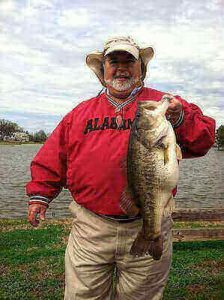
4. Worms, grasshoppers, and crickets are some of the best live baits to fish nesting bluegill. Set the bait 1 to 3 feet below a tiny bobber. These are some of the best baits for bluegill and this is one of the best bluegill fishing tips to always implement.
5. Bluegill that is not spawning can be found in deeper waters. During summer, they will be in deeper water on large lakes. However, they will remain shallow in ponds to get oxygen.
6. Wax worms and mealworms are the best live bait for catching bluegill in the winter. Small jigs, tiny spoons, and artificial flies are also used to catch bluegill in the winter.
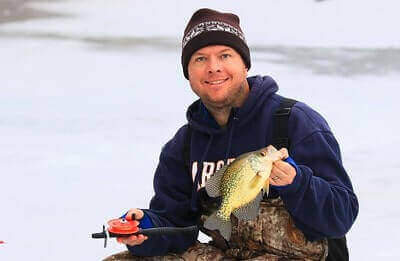
7. The largest bluegills are found in farm ponds that receive less fishing pressure. This article on how to fish in a pond will help you become successful in fishing from a pond.
8. Bluegill will usually be found where there is fresh water and a lot of aquatic vegetation. Target aquatic vegetation and fresh water and you will be richly rewarded with bluegill. Put this in your bag as one of the best bluegill fishing tips to take with you in your fishing career.
9. Slowly descend your lure as it gives the bluegill time to react. Give it time to notice your lure as it descends. Don’t hurry to the bottom.
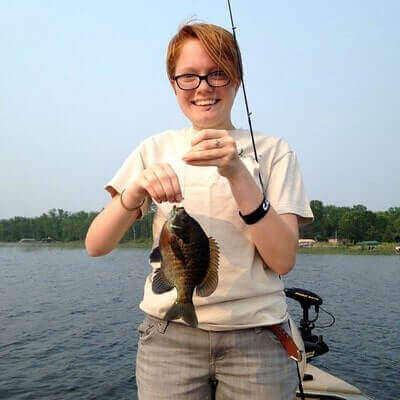
10. Bluegills have a natural diet and the best live bait for bluegills is cricket. When everything you tried didn’t get you the bluegill, try live crickets.
11. When you are fishing on a large lake and the weather is hot, it is better to go deeper in search of bluegills. They will go down to cooler temperatures where they still get oxygen. Using a slip float will allow you to go deep for the bluegills.
12. Bluegills will hang around docks for cover to provide protection from predators and avoid the heat. However, when the water is high and the dock is low, it can be challenging to reach them. Some will even go to deeper areas where they can’t be targeted with casting. In such situations, the only option is to shoot them.
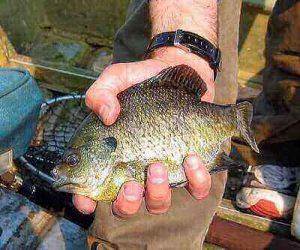
13. Bluegill mainly feed during daylight hours as they are sight feeders.
14. Use an ultralight rod, reed, tackle, and a 2 to 6-pound test line. You will feel the bluegill bite more effectively and catch more bluegill with the use of a light line. Additionally, when fishing clear water, a light line is harder for the bluegill to detect it.
15. Always keep the live bait or lures small if you want to catch a lot of bluegills. Go with hook sizes from No. 6 to No. 10. Also use hooks with long shanks that will make it easier to remove the hooks from the bluegill’s mouth.
16. Spring and summer is the best time to fish for bluegill. At this time, they will be in about 2 to 6 feet of water under cover. There can be about 50 nests in a spawning bed during the spawn.
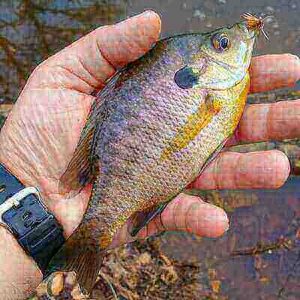
17. Bluegill will be found in deeper waters after the spawning period traveling in large schools.
18. You can find bluegill in the same locations in late summer and target them in shallower waters near weed beds, brush, and other types of cover. Early morning and evening are the best times to fish during summer, but as the water cools in the fall, you can be successful in fishing bluegill during midday.
How To Catch Bluegill In Florida
When fishing for Bluegill in Florida, concentrate on water that has a depth of 6 feet or less and use live worms or crickets. Fish for bluegill at the bottom using these baits or suspended using a float. Other baits such as sand maggots, grass shrimp, and grubs can also be used to catch bluegill. Use a small hook, preferably #6 or #8 with a split shot sinker about 6 inches up the line.
How To Catch Bluegill With Lures
When fishing for bluegill with lures, a 1/8 oz. “beetle spin” with a white or chartreuse body on ultralight tackle is very effective. Small spinners, curly tail grubs, and popping bugs are also used when fishing for bluegill. Look for docks, fallen trees, weed lines, and other structures that Bluegill can use as cover.
If you are targeting larger bluegills, then small plugs will work. Be careful and do not let your lures move too fast as Bluegill is not fond of anything that moves too fast. If you are fishing on a large river or lake, trolling lures will work great.
How To Catch Bluegill Without Worms
There are advantages and disadvantages when fishing with live bait. You have to keep them alive while fishing and there is always the mess you have to deal with like the soil for worms.
The good news is that you can fish for bluegills with live bait or artificial lures. Jig, bugs. small spinners and curly tail grubs are some of the best lures to use when fishing for bluegill.
Best Bait For Bluegill
1. Wax Worms
Wax worms are an effective and popular bait choice for anglers targeting bluegill, esteemed freshwater panfish known for their abundance and willingness to bite. These small, creamy-white larvae emit a natural scent and possess subtle movements that entice bluegill to strike.
Anglers typically rig wax worms on small hooks beneath a bobber or float and present them near submerged structures, weed beds, or other areas where bluegill is known to congregate. The lively action and enticing aroma of the wax worms provoke aggressive strikes from bluegill, making them a favored bait option.
Whether fished slowly near the bottom or suspended in the water column, wax worms offer versatility and effectiveness in enticing bluegill into biting. With their availability at bait shops and proven success in attracting bluegill, wax worms provide anglers with a reliable and rewarding option for pursuing these prized freshwater panfish, ensuring an enjoyable and productive fishing experience on the water.
2. Meal Worms
Mealworms are a highly effective and popular bait choice among anglers targeting bluegill, esteemed freshwater panfish known for their abundance and willingness to bite. These small, soft-bodied larvae emit a natural scent and possess subtle movements that entice bluegill to strike.
Anglers typically rig mealworms on small hooks beneath a bobber or float and present them near submerged structures, weed beds, or other areas where bluegill are known to congregate. The wriggling action and enticing aroma of the mealworms provoke aggressive strikes from bluegill, making them a favored bait option.
Whether fished slowly near the bottom or suspended in the water column, mealworms offer versatility and effectiveness in enticing bluegill into biting. With their availability at bait shops and proven success in attracting bluegill, mealworms provide anglers with a reliable and rewarding option for pursuing these prized freshwater panfish, ensuring an enjoyable and productive fishing experience on the water.
3. Crickets
Crickets are a highly effective and popular bait choice for anglers targeting bluegill, esteemed freshwater panfish known for their abundance and willingness to bite. These small insects emit a natural scent and possess lively movements that entice bluegill to strike.
Anglers typically rig crickets on small hooks beneath a bobber or float and present them near submerged structures, weed beds, or other areas where bluegill is known to congregate. The wriggling action and enticing aroma of the crickets provoke aggressive strikes from bluegill, making them a favored bait option.
Whether fished slowly near the bottom or suspended in the water column, crickets offer versatility and effectiveness in enticing bluegill into biting. With their availability at bait shops and proven success in attracting bluegill, crickets provide anglers with a reliable and rewarding option for pursuing these prized freshwater panfish, ensuring an enjoyable and productive fishing experience on the water.
4. Grasshoppers
Grasshoppers serve as a natural and effective bait choice for anglers targeting bluegill, esteemed freshwater panfish known for their abundance and willingness to bite. These terrestrial insects emit a natural scent and possess lively movements that entice bluegill to strike. Anglers typically rig grasshoppers on small hooks beneath a bobber or float and present them near submerged structures, weed beds, or other areas where bluegill are known to congregate.
The hopping action and enticing aroma of the grasshoppers provoke aggressive strikes from bluegill, making them a favored bait option. Whether fished slowly near the bottom or suspended in the water column, grasshoppers offer versatility and effectiveness in enticing bluegill into biting.
With their availability in grassy areas and proven success in attracting bluegill, grasshoppers provide anglers with a natural and rewarding option for pursuing these prized freshwater panfish, ensuring an enjoyable and productive fishing experience on the water.
5. Nightcrawlers
Nightcrawlers, also known as earthworms, are a classic and highly effective bait choice for anglers targeting bluegill, esteemed freshwater panfish known for their abundance and willingness to bite. These large, wriggling worms emit a natural scent and possess lively movements that entice bluegill to strike.
Anglers typically rig nightcrawlers on small hooks beneath a bobber or float and present them near submerged structures, weed beds, or other areas where bluegill are known to congregate. The enticing aroma and lifelike movements of the nightcrawlers provoke aggressive strikes from bluegill, making them a favored bait option.
Whether fished slowly near the bottom or suspended in the water column, nightcrawlers offer versatility and effectiveness in enticing bluegill into biting. With their widespread availability and proven success in attracting bluegill, nightcrawlers provide anglers with a reliable and rewarding option for pursuing these prized freshwater panfish, ensuring an enjoyable and productive fishing experience on the water.
6. Red Worms
Red worms, also known as red wigglers, are a highly effective and popular bait choice for anglers targeting bluegill, esteemed freshwater panfish known for their abundance and willingness to bite. These small, slender worms emit a natural scent and possess lively movements that entice bluegill to strike.
Anglers typically rig red worms on small hooks beneath a bobber or float and present them near submerged structures, weed beds, or other areas where bluegill are known to congregate. The enticing aroma and wriggling action of the red worms provoke aggressive strikes from bluegill, making them a favored bait option. Whether fished slowly near the bottom or suspended in the water column, red worms offer versatility and effectiveness in enticing bluegill into biting.
With their availability at bait shops and proven success in attracting bluegill, red worms provide anglers with a reliable and rewarding option for pursuing these prized freshwater panfish, ensuring an enjoyable and productive fishing experience on the water.
7. Crickets
Crickets are an excellent bait choice for anglers targeting bluegill, esteemed freshwater panfish known for their abundance and willingness to bite. These small insects emit a natural scent and possess lively movements that attract bluegill to strike.
Anglers typically rig crickets on small hooks beneath a bobber or float and present them near submerged structures, weed beds, or other areas where bluegill are known to congregate. The wriggling action and enticing aroma of the crickets provoke aggressive strikes from bluegill, making them a favored bait option.
Whether fished slowly near the bottom or suspended in the water column, crickets offer versatility and effectiveness in enticing bluegill into biting. With their availability at bait shops and proven success in attracting bluegill, crickets provide anglers with a reliable and rewarding option for pursuing these prized freshwater panfish, ensuring an enjoyable and productive fishing experience on the water.
8. Leeches
Leeches are a natural and effective bait choice for anglers targeting bluegill, esteemed freshwater panfish known for their abundance and willingness to bite. These aquatic invertebrates emit a distinct scent and possess subtle movements that attract bluegill to strike.
Anglers typically rig leeches on small hooks beneath a bobber or float and present them near submerged structures, weed beds, or other areas where bluegill are known to congregate. The undulating movement and enticing aroma of the leeches provoke aggressive strikes from bluegill, making them a favored bait option.
Whether fished slowly near the bottom or suspended in the water column, leeches offer versatility and effectiveness in enticing bluegill into biting. With their availability at bait shops and proven success in attracting bluegill, leeches provide anglers with a natural and rewarding option for pursuing these prized freshwater panfish, ensuring an enjoyable and productive fishing experience on the water.
9. Goldenrod Grubs
Goldenrod grubs, the larvae of the goldenrod gall fly, are a highly effective bait choice for anglers targeting bluegill, esteemed freshwater panfish known for their abundance and willingness to bite. These small, creamy-white grubs emit a natural scent and possess subtle movements that entice bluegill to strike.
Goldenrod grubs are usually rigged on small hooks beneath a bobber or float and present them near submerged structures, weed beds, or other areas where bluegill are known to congregate. The wriggling action and enticing aroma of the grubs provoke aggressive strikes from bluegill, making them a favored bait option.
Whether fished slowly near the bottom or suspended in the water column, goldenrod grubs offer versatility and effectiveness in enticing bluegill into biting. With their availability and proven success in attracting bluegill, goldenrod grubs provide anglers with a natural and rewarding option for pursuing these prized freshwater panfish, ensuring an enjoyable and productive fishing experience on the water.
10. Minnows
Minnows are a versatile and effective bait choice for anglers targeting bluegill, esteemed freshwater panfish known for their abundance and willingness to bite. These small fish emit a natural scent and possess lively movements that entice bluegill to strike.
Anglers typically rig minnows on small hooks beneath a bobber or float and present them near submerged structures, weed beds, or other areas where bluegill are known to congregate. The swimming action and enticing aroma of the minnows provoke aggressive strikes from bluegill, making them a favored bait option. Whether fished slowly near the bottom or suspended in the water column, minnows offer versatility and effectiveness in enticing bluegill into biting.
With their availability at bait shops and proven success in attracting bluegill, minnows provide anglers with a reliable and rewarding option for pursuing these prized freshwater panfish, ensuring an enjoyable and productive fishing experience on the water.
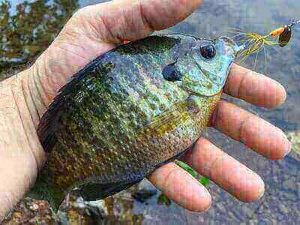
Best Artificial Lures For Bluegill
1. Poppers
Poppers are an exciting and effective lure choice for anglers targeting bluegill, esteemed freshwater panfish known for their abundance and willingness to bite. These lures feature a concave face that creates a popping or splashing action when retrieved across the water’s surface, mimicking the sound of insects or small prey struggling on the surface.
Poppers are usually used by anglers in calm water conditions near submerged vegetation, weed beds, or other areas where bluegill is known to congregate. The commotion created by the popper’s action attracts bluegill from below, prompting aggressive strikes. Poppers come in various sizes and colors to match the preferences of bluegill in different conditions.
Whether cast and retrieved slowly or worked with quick jerks to create more erratic movements, poppers offer versatility and effectiveness in enticing bluegill into striking. With their exciting action and proven success in attracting bluegill, poppers provide anglers with a thrilling and rewarding option for pursuing these prized freshwater panfish, ensuring an enjoyable and productive fishing experience on the water.
2. Plastic Minnows
Plastic minnows, also known as soft plastic swimbaits, are a versatile and effective lure choice for anglers targeting bluegill, esteemed freshwater panfish known for their abundance and willingness to bite. These lures typically mimic the appearance and swimming action of small baitfish, making them highly attractive to bluegill.
Anglers can rig plastic minnows on small jigheads or hooks and present them near submerged structures, weed beds, or other areas where bluegill is known to congregate. The lifelike movement and realistic appearance of plastic minnows provoke aggressive strikes from bluegill, making them a favored lure option.
Whether retrieved slowly to mimic injured prey or worked with jerks and pauses to imitate fleeing baitfish, plastic minnows offer versatility and effectiveness in enticing bluegill into striking. With their availability in various sizes, colors, and designs, plastic minnows provide anglers with a reliable and rewarding option for pursuing these prized freshwater panfish, ensuring an enjoyable and productive fishing experience on the water.
3. Spinnerbaits
Spinnerbaits are an effective and versatile lure choice for anglers targeting bluegill, esteemed freshwater panfish known for their abundance and willingness to bite. These lures typically consist of a metal wire frame adorned with one or more spinning blades and a skirted jighead, mimicking the appearance of small baitfish or insects.
Anglers can choose from a variety of spinnerbait sizes, colors, and blade designs to match the preferences of bluegill in different conditions. Spinnerbaits are typically retrieved at a steady pace, allowing the blades to spin and create flashes of light and vibrations that attract bluegill from a distance. Anglers can fish spinnerbaits near submerged structures, weed beds, or other areas where bluegill is known to congregate.
The enticing movement and realistic appearance of spinnerbaits provoke aggressive strikes from bluegill, making them a favored lure option. With their versatility and proven effectiveness in attracting bluegill, spinnerbaits provide anglers with a reliable and rewarding option for pursuing these prized freshwater panfish, ensuring an enjoyable and productive fishing experience on the water.
4. Jigs
Jigs are a highly effective and versatile lure choice for anglers targeting bluegill, esteemed freshwater panfish known for their abundance and willingness to bite. These lures typically consist of a lead head adorned with a soft plastic body or feathers, mimicking the appearance of small baitfish, insects, or other prey.
Anglers can choose from a variety of jig sizes, colors, and styles to match the preferences of bluegill in different conditions. Jigs can be retrieved at varying speeds and depths, allowing anglers to target bluegill near submerged structures, weed beds, or other areas where they congregate.
The lifelike movement and realistic appearance of jigs provoke aggressive strikes from bluegill, making them a favored lure option. Jigs provide anglers with a reliable and rewarding option for pursuing these prized freshwater panfish, ensuring an enjoyable and productive fishing experience on the water.
5. Soft Plastics
Soft plastics are a versatile and effective lure choice for anglers targeting bluegill, esteemed freshwater panfish known for their abundance and willingness to bite. These lures typically consist of pliable, synthetic materials molded into various shapes and sizes, such as worms, grubs, or minnow imitations.
Anglers can choose from a wide range of soft plastic colors and designs to match the preferences of bluegill in different conditions. Soft plastics can be rigged on small hooks or jigheads and presented near submerged structures, weed beds, or other areas where bluegill is known to congregate. The natural movement and realistic appearance of soft plastics provoke aggressive strikes from bluegill, making them a favored lure option.
Whether retrieved slowly to mimic injured prey or worked with jerks and pauses to imitate fleeing baitfish, soft plastics offer versatility and effectiveness in enticing bluegill into striking. With their availability in various sizes, colors, and designs, soft plastics provide anglers with a reliable and rewarding option for pursuing these prized freshwater panfish, ensuring an enjoyable and productive fishing experience on the water.
The Bottom Line
Bluegill is one of the most popular panfish species. It is abundant, tasty, and popular with fly-fishing anglers. In this article, we share bluegill fishing tips to help you learn how to catch and take more bluegill home. We hope that you will learn something that can elevate your fishing for bluegills whether you are a beginner or an experienced angler.
You can learn how to catch more fly fish after reading this article about fly fishing tips. If you also fish for walleye, then you can catch more walleye after reading this article about walleye fishing tips.
